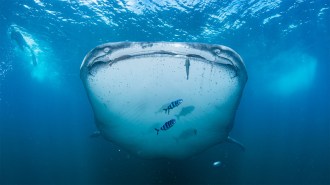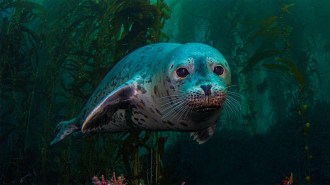Plight of the Iguanas: Hidden die-off followed Galápagos spill
The 3-million-liter oil spill in the Galpagos Islands last year may not have been as mild as touted at the time. A research team now blames the spill for a 62 percent loss in one island’s famed marine iguanas.

The iguanas on Santa Fe Island didn’t keel over in huge numbers immediately after the spill, says Martin Wikelski of Princeton University. However, when his research team returned about a year later, the iguana population had shrunk dramatically and skeletons littered the shores.
The researchers have been tracking this colony for 20 years, and they say they’ve never recorded such a die-off in a year with otherwise favorable climatic conditions. In the June 6 Nature, they attribute the carnage on Santa Fe to “a small amount of residual oil contamination in the sea.”
Biological consultant Robert Spies of Applied Marine Sciences in Livermore, Calif., has studied the aftermath of the Exxon Valdez spill in Alaska. He laments that scientists know much less about the dangers of lingering traces of oil than about the immediate effects of spills (see “Most oil enters sea from nonaccidents,” in this week’s issue: Available to subscribers at Most oil enters sea from nonaccidents). He acknowledges the difficulties of tracing effects of dilute pollutants, and he calls the new report a “very strong case for low-level effects of marine pollution in this setting.”
The big, surf-diving iguanas of the Galpagos, Amblyrhynchus cristatus, were just one of the species that the world’s nature lovers feared for during the tense days after a tanker struck San Cristóbal Island on Jan. 17, 2001. Some individual animals perished, but the oil largely dispersed out to sea without doing as much immediate damage as biologists had dreaded. Wikelski’s assistants on the island found that the iguanas had unusually high concentrations of the stress hormone corticosterone in their blood but otherwise seemed to be feeding and behaving as usual.
When the researchers returned the following winter, however, they found that many of the iguanas they’d known from hatchlings had disappeared. The study colony’s previous population of some 4,000 iguanas had plunged to about 1,500.
Unlike Santa Fe, the small island of Genovesa to the north wasn’t in the path of the drifting oil. Its iguana population last winter hadn’t declined from the previous year, the researchers found.
They had seen four earlier major declines on Santa Fe–all after El Nios caused food shortages. This time, climate didn’t explain the drop, says Wikelski. He suggests that when iguanas ate oil-tainted food, their gut bacteria failed, and they could no longer digest algae.
Spies says that Santa Fe offered an unusual opportunity to look for the biological effects of oil residues. For example, researchers didn’t have to worry about confounding effects of predators or many other pollutants there.
Judith E. McDowell of Woods Hole Oceanographic Institution in Massachusetts advises caution, though. In the Galpagos, “the circumstantial evidence would certainly suggest that oil exposure was a critical factor in controlling survival of the iguanas,” she notes. However, there’s no data on actual oil concentrations in water, food, or animal tissue, so “it would be difficult to say more,” she adds.






